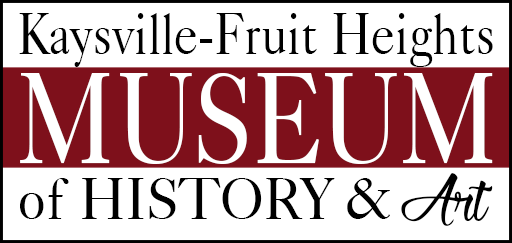
Samuel Ashton Cabin
Pioneer home of Samuel Ashton and his wife Mary. It was located on the mountain road just one-half mile north of Bair Canyon, in Fruit Heights. This picture (sepia tone) of Samuel Ashton’s Cabin abt. 1869 was taken by Andrew J. Russell and is from the Forest Barker Collection.
In the photo from left to right are: Ellen Bunting Young, Eliza Ward, Ann Slater Bunting, Mary Bunting Ashton, Samuel Ashton, Sarah Ann Bunting Bosworth, Samuel Ward, Ann Bunting Ward, Ann Ward, William Ward, Emma Ward
(as noted on the back of the photo)

 Mary was a very capable strong woman. They had no children, but Aunt Mary Ashton (as she was respectfully called by everyone) was the one who answered the call for help when babies arrived or when sickness and trouble struck anywhere in the settlement. She was their doctor and they depended on her to help, with or without pay, which she did unselfishly.
Mary was a very capable strong woman. They had no children, but Aunt Mary Ashton (as she was respectfully called by everyone) was the one who answered the call for help when babies arrived or when sickness and trouble struck anywhere in the settlement. She was their doctor and they depended on her to help, with or without pay, which she did unselfishly.
Their house was the center of activities for friends and relatives. It was one large room with a rag carpet covering the floor. Between the door and the window was a wash bench holding a water bucket with a dipper in it, and a large earthen pan for washing the hands, face, neck and ears. Against the west wall was the big cook stove with eight lids or openings in the top for cooking; and a huge oven where she baked large loaves of bread; and on the right hand side of the stove, fitted against the oven was a big iron box like a reservoir, which held four or five gallons of water. Wood from the wood box kept the fire going and heated the water in the reservoir which was dipped out for use and was supplemented by a big black iron teakettle on top of the stove. In the corner to the right of the stove was a cupboard with glass doors containing their few really nice pieces of china and the every day utensils. The churn was kept between the cupboard and the stove. in the center of the north wall was a large painting depicting life from the cradle to the grave. It showed a baby in a cradle; some children running with a hoop; a young man fishing in a pond at the side; two lovers strolling; and old folks sitting in chairs on the porch of the spacious mansion. The colors in this picture were beautiful and Mary never tired of explaining it in detail to any children who were visiting them. Next to the picture was a north window and in the corner stood the big wooden bedstead with its buoyant, feather filled thick and intricately pieced quilts. A huge bolster lay at the head of the bed. In the southeast corner was a wooden chest, which held Samuel’s and Mary’s Sunday clothes as well as other cherished things. In the window next to the door she had potted plants, and just outside of the door she planted marigolds and moss roses.
In the picture you see Mary standing at the spinning wheel**; the little girl is her neice, Eliza Ward (Boulton); the little lady sitting in the rocking chair is Mary’s mother, Ann (Slater) Bunting; then, her sister standing by the door, Ellen Ward (Young); and sitting in the doorway is Samuel Ashton (Mary’s husband); next to him standing with the churn is Sarah Bunting Bosworth; next is another sister, Ann Bunting Ward, with four of her childdren, Samuel Ward, Annie Ward (Bacon) (still living 1976) William Ward, and Emma Ward (Chapman), the young girl standing in front of the old hand cart, which Samuel and Mary Ashton pushed across the plains. This picture was taken by a passing pioneer photographer, C. R. Savage, from Salt Lake City, who called in for a rest and a drink of water. He thought this group, of mother and daughters busily engaged at their sewing bee, was so picturesque he could not refrain from photographing it.
By Mary Harvey Phelps From the book: East of Antelope Island, DUP
**Note: That is not Mary standing at the spinning wheel; it is actually Ellen Ward Young.


These photos gained national exposure as a typical Utah Mormon polygamist home, though in reality, no one in the photo was a polygamist. The people in the photo were all visiting the Ashtons when the photographer(s) happened along. The Cabin was located in Kaysville Utah and the photo was taken in 1869, reportedly by Andrew J. Russell on his way to photograph the meeting of the railroads at Promontory Point. Also reported that Charles R. Savage took the picture (He was traveling with Russell and took an almost identical photo.) There are two almost identical photos obviously taken at the same time where a few minor changes in some of the subject’s poses are apparent. DUP account
